An Illustrated History of Kazakhstan: Asia's Heartland in Context
When I was in graduate school, I lived and learned amidst dozens of languages, cultures, people. There were many international scholars in our program, who braved the cold Minnesota winters in search of knowledge, community, and camaraderie. What I loved most about that was the chance to learn, in-depth, about the world from a diverse group of people. Now we have the internet to help us learn some of those things, but it isn’t quite the same, is it? So we need to travel, immerse ourselves in cultures, and create long-lasting, global friendships with people. And, being an academic, I’m all about the research. I love finding books that can truly give the essence of a culture – and make me want to visit. I’m not talking travel guides, but in-depth, well-researched books that share things we can’t find online - things that our global friends can teach us.
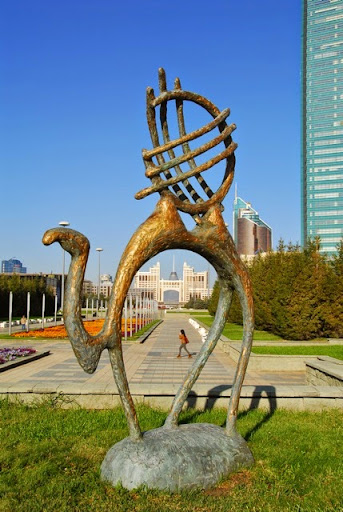
Camel statue carrying a shangyrak (circular roof opening of a yurt) in Astana. Jeremy Tredinnick
Enter An Illustrated History of Kazakhstan: Asia's Heartland in Context, by Jeremy Tredinnick. This is, hands down, the best book I’ve ever read about a country, culture, history, and people. It is full of chapters that beautifully illustrate the remarkable history of Kazakhstan – written by experts in each field.
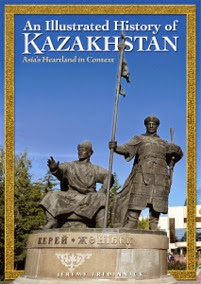
Photo courtesy of: Jeremy Tredinnick
Contents include:
- Prehistory
- Early civilizations
- The Golden era
- The Silk Road
- Turkic expansion
- The Mongol era
- Rise of the Kazakh Khanate
- The Russian empire
- The Soviet era
- A New nation
- The New millennium
- Timeline

Kazakh chiefs and begs in the 19th century
And many maps, hundreds of photos, and inspiration and education galore. What I love about this book is that it taught me about a place I’ve longed to learn about - in an intelligent way. This isn’t a travel guide – it’s a culture guide. There’s a difference, and it’s well worth reading. If you haven’t explored the rich, vibrant, creative culture that is Kazakhstan yet, dig in – this book will illuminate the extraordinary Kazakh culture, people, and landscape.
Highly recommended!

A dynamic miniature showing the fierce battle between Timur and Tokhtamysh's armies. Courtesy of the Academy of Sciences of Uzbekistan
We were lucky enough to catch up with Jeremy, to learn more about the book, the experts he includes, inspiration, Kazakhstan’s rich cultural history, and more. Here’s what he had to say…
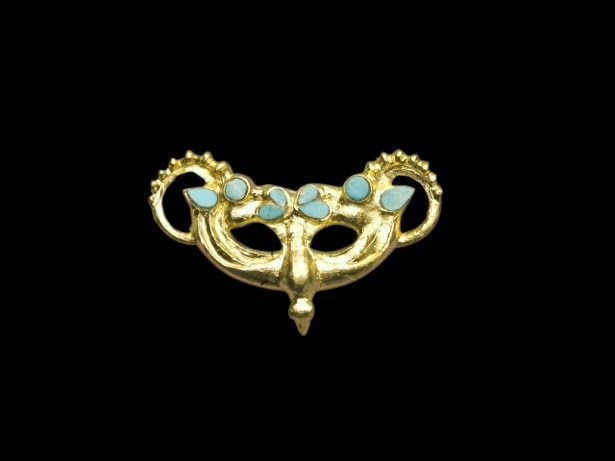
A Saka plaque in gold and turquoise depicting a snow leopard, twin argalis, and a flying bird. Courtesy of the Central State Museum of the Republic of Kazakhstan
Please tell us about your book, An Illustrated History of Kazakhstan: Asia's Heartland in Context...
I had already produced a few books and maps about Kazakhstan for Odyssey and various departments of the Kazakhstani government. After an exhibition of ancient Saka art titled "Nomads and Networks: The Ancient Art and Culture of Kazakhstan" toured the US, complemented by a book of the same name, members of the Kazakhstan Embassy to the US were inspired to discuss with Odyssey's publisher, Magnus Bartlett, the idea of producing a comprehensive history of the Central Asian region that is now Kazakhstan, from pre-human history right through to the modern day.
Such a book did not exist in the English language, let alone in a non-academic work. Most English writing on Kazakhstan was academic or focused on politics or economics. The idea of this book was to present an all-encompassing history of the region to a more mainstream readership, in a way that would be entertaining and informative but also retain academic credibility.

Holy Ascenion Cathedral, Almaty - made entirely of wood. Photo courtesy of Jeremy Tredinnick

Golden plaque of a horned deer with folded legs, part of the Zhalauly treasure discovered in the Almaty region and dating to between the seventh and sixth centuries BCE. Courtesy of the Central State Museum of the Republic of Kazakhstan
What inspired you to write this book?
The initial inspiration came from a member of staff of then-Ambassador to the US, Erlan Idrissov (he is now Minister of Foreign Affairs in Kazakhstan), who bemoaned the lack of easily readable English literature about his country's past. When Magnus approached me with the brief as stated above, I was intrigued and excited by the challenge. To make a large history book accessible to people who are educated and interested but who don't necessarily have any academic background is a tricky proposition, and to do it all within a year was quite a task - but one which I thought I could do given that I had already produced a guidebook to Kazakhstan containing a condensed history, and had a good basic network of contacts related to the subject.
I was also interested to research and source images to fill the book - these, I knew, would come from a diverse set of locations (Russian, Chinese, Kazakhstani, Uzbekistani, Turkish, French, British and US museums and organisations/institutions), and I love to delve into the amazing resources these places contain.
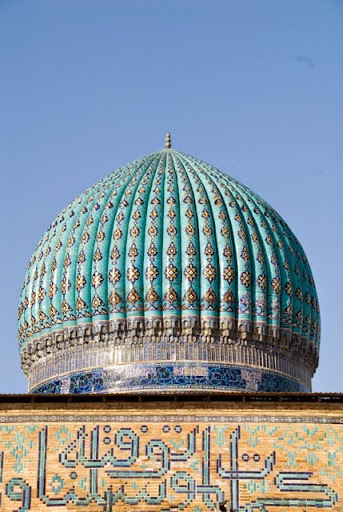
Ribbed dome of the Mausoleum of Khoja Ahmed Yasawi in Turkistan, south Kazakhstan. Photo courtesy of Jeremy Tredinnick

'The Turketan-Siberian Railway,' a painting by Ablaikhan Kasteyev (1904-1973). Photo courtesy of Jeremy Tredinnick
You have SO many experts, from a plethora of fields, as contributors (it's amazing!). How did you find them - and choose whom to include?
I created a synopsis of the book with the basic chapter structure and my ideas for images and maps, and once this was approved by the client and publisher, I prepared a list of experts for each chapter or period in history, and sent these off for approval. The idea was to have an expert essay in each chapter that either covered the whole period or a significant subject, such as Silk Road trade, within that period. I would then write an introduction text at the start of each chapter that would link the essays together, adding any relevant information that the essays omitted, and creating a flow to the text so that it read seamlessly.
I already knew a number of archaeologists and historians from previous books I had produced, but I also did a lot of research both online and at libraries such as the British Library in London, Oxford's Bodleian Library, and the Royal Society of Asian Affairs, as well as the Hermitage Museum in St Petersburg, the National Library of Russia, the USA's Smithsonian, and the Library of Congress. From these I garnered names of academics, economists, historians, etc. who had written books or papers on the subject matter.
The clients (a combination of the Kazakhstan US Embassy and Kazakhstan's Ministry of Foreign Affairs) had final say over who would be asked to contribute - they only rejected one name, but they also gave suggestions of some others, whom I contacted. The response when I contacted these experts was very positive - everyone seemed to understand that this could be a very worthwhile project - but for various reasons, some people could not participate. However, I had a deep enough pool of names to be able to compile a really good range of well-respected individuals.
I also felt that at least half of the contributors should be Kazakhstanis, so that the book would be seen to have a good balance of views, both national and international... as it turned out, we had a majority of Kazakhstani contributors involved, which was pleasing (although it meant a lot more work for me in editing and often almost completely rewriting text that had either been written in Russian and translated, or written in English by non-native English speakers).
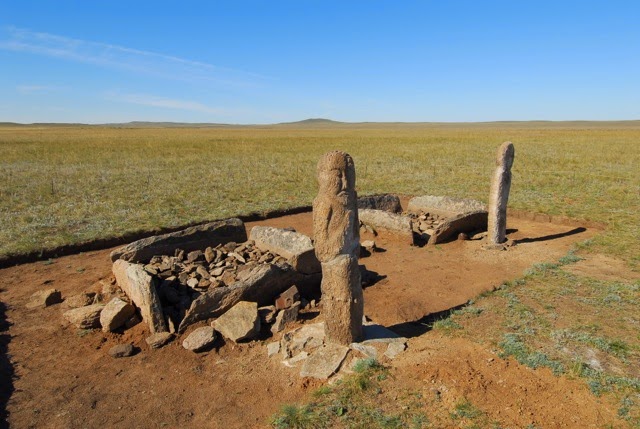
Kumai archaeological complex in central Kazakhstan - a sacred place for nomads through the ages. Photo courtesy of Jeremy Tredinnick

Frontispiece of the Golden Man's headress, showing two winged horses with ibex horns, the mixing of animal forms typical of Scytho-Siberian art. Courtesy of the Nazarbayev Center, Astana
Kazakhstan has a culturally rich history - despite invasions and belonging to other cultures/empires. Why do you think this is? What is it about the Kazakh people that remains true to themselves, taking in and adapting but keeping the essence?
The Kazakhs are a people created by their environment. The vast steppes and mountains of Central Asia were a harsh environment to live in, and the nomadic lifestyle and culture evolved to cope with it perfectly. All the nomadic Central Asian cultures (Kazakh, Mongol, Kyrgyz, etc) place great importance on hospitality and helping strangers (no one could survive alone, so a traveller could approach a nomadic encampment and would be given food, shelter, and assistance on their onward journey - this is a prerequisite to life on the steppe). During the Stalin era when ethnic peoples like Koreans, Germans, Chechens, etc. were being forced to resettle in the Great Steppe, many were aided by Kazakhs who showed them how to build shelters and find food in the new and very harsh world - many survived because of this.
Kazakhs remain bound by their nomadic heritage, and now that the country is independent and cultural expression is not repressed, they are reconnecting with it - and equally importantly, the many ethnic groups represented in the country, who are not Kazakh but are Kazakhstani, are also allowed to retain their own cultures. One of the best things the newly independent Kazakhstan government did was set out its camp from the beginning as a secular and mulitcultural nation. This is one of its great strengths.
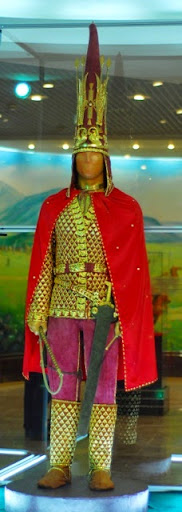
The Golden Man (replica). Photo courtesy of Jeremy Tredinnick

Russian official and his wife with Kazakhs. Library of Congress, Prints & Photographs Division
Research for the book must have been extremely interesting - tell us more! (including finding the extraordinary photos, please...)
I've already talked about the image research - it was a huge amount of work, involving a lot of website searching through thousands of thumbnail images, as well as countless emails and letters/faxes to different institutions. It is often hugely frustrating when dealing with these museums/organisations, both because English communication can be hard, and also because cultural and tech differences can mess up potential deals and agreements. However, I have plenty of experience in Asia doing this, so I have become adept at finding "solutions" to the many obstacles that appear during negotiations.
St Petersburg's Kunstkamera museum in particular has a wonderful collection of B&W photos, almost all scanned, from Central Asia in the 19th and early 20th century - as does the Library of Congress in the US. It can take days to go through all the material and find the best images for your purpose. I actually asked to buy rights to use 30 images from the Kunstkamera, but the rates were so high that in the end we only used 15.
There are also wonderful surprises sometimes when you discover a source that is of great quality and is very important to your project - this happened with the An Jia sarcophagus, held in Lanzhou in Shaanxi province in China - the carved panels show friendly relations and trade between the Sogdian town merchants and Turkic nomads in the 6th century, which tie in perfectly with the book's revelation that the nomads were more often allies and protectors of the cities on the ancient trade routes than enemies.
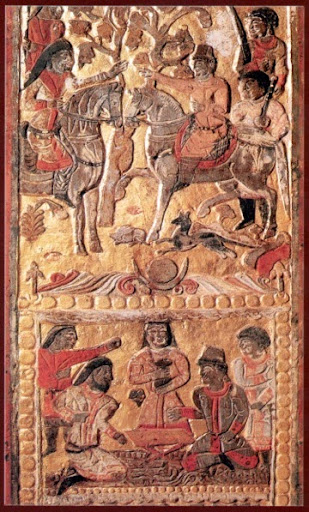
A nomadic Turkic khagan (ruler) holds friendly discussions with the Sogdian official An Jia in this panel from the sixth century CE An Jia sarcophagus. Courtesy of the Shaanxi Provincial Institute of Archaeology

Sultan Baimuhammed by S. Aleksandrovsky. 1889. Photo courtesy of the National Library of Russia Manuscripts Department.
If you had to share one thing about Kazakhstan, to increase awareness, learning, and inspire people to visit, what would it be?
People often go on holiday to a new or unusual country either because it is geographically beautiful or because the people and their culture are lovely. Well, Kazakhstan can boast high marks in both those areas - its mountains are stupendous, the steppe is an otherworldly, atmospheric place for the majority of people, and the population is full of rich culture and hospitality. This is a country whose history runs deep and far back, it is a place whose people have been through hard times but come out the other side strong and positive, not embittered, and its resources are such that it has the potential to become a major world player. Tourism is still in its infancy here really - and I always think that is the best time to go and explore.
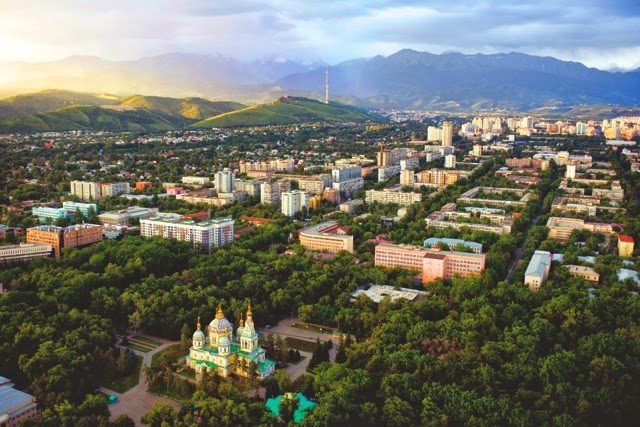
Almaty, Kazakhstan. Photo Courtesy of Berik Barysbekov/CAPro
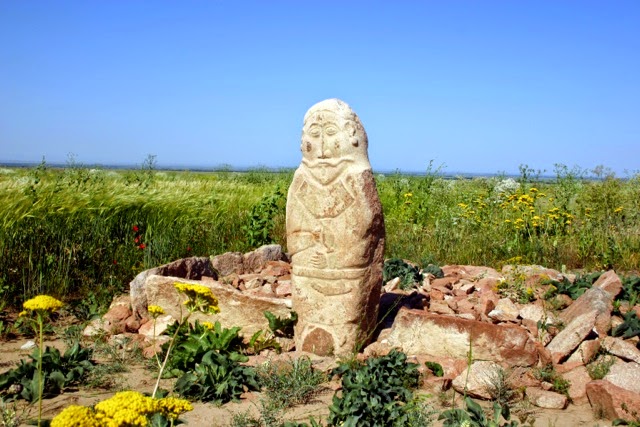
Balbal at the Zhayan site in the Chu Valley - see the dagger hanging from his belt, a cup in his right hand, and an impressive mustache. Courtesy of Alan Aydakhar
What's up next for you?
I am not sure - I do not have any new book projects lined up. It is possible that another government may see this book and request a similar book for their own country, but I may opt for a change of pace and go back into an office job in publishing here in Hong Kong. I have various regular part-time jobs here, but I am open to suggestions... money worries withstanding, it's quite a nice position to be in!

Kazakhstan President Nazarbayev.
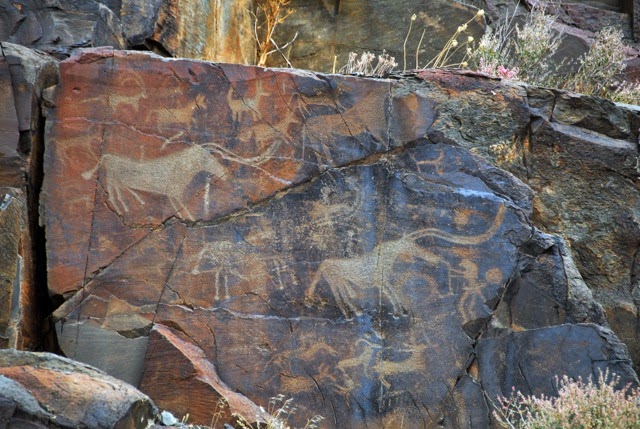
Petroglyphs at the Tamgaly Archaeological Landscape, a UNESCO World Heritage Site. Photo courtesy of Jeremy Tredinnick
To learn more, please see: http://www.odysseypublications.com/publicationsPublication.php?publicationID=00114
You can find the book at both online and local booksellers.
Note: We received a review copy of An Illustrated History of Kazakhstan: Asia's Heartland in Context from the publisher – thank you!





















